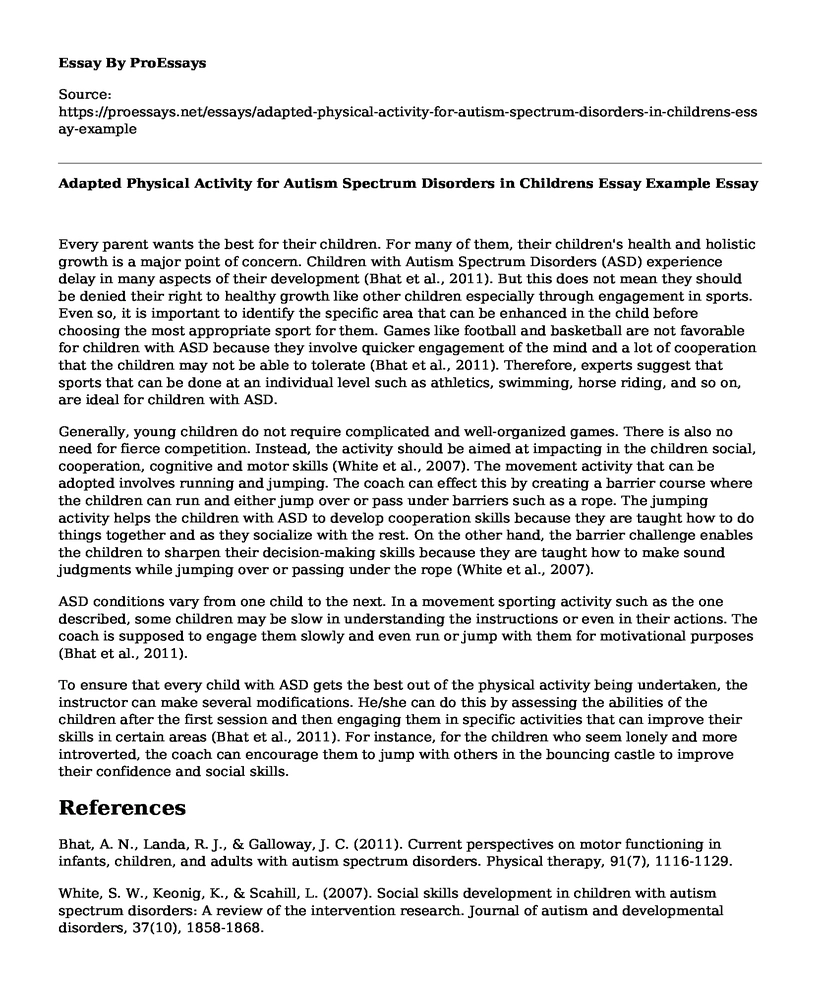Every parent wants the best for their children. For many of them, their children's health and holistic growth is a major point of concern. Children with Autism Spectrum Disorders (ASD) experience delay in many aspects of their development (Bhat et al., 2011). But this does not mean they should be denied their right to healthy growth like other children especially through engagement in sports. Even so, it is important to identify the specific area that can be enhanced in the child before choosing the most appropriate sport for them. Games like football and basketball are not favorable for children with ASD because they involve quicker engagement of the mind and a lot of cooperation that the children may not be able to tolerate (Bhat et al., 2011). Therefore, experts suggest that sports that can be done at an individual level such as athletics, swimming, horse riding, and so on, are ideal for children with ASD.
Generally, young children do not require complicated and well-organized games. There is also no need for fierce competition. Instead, the activity should be aimed at impacting in the children social, cooperation, cognitive and motor skills (White et al., 2007). The movement activity that can be adopted involves running and jumping. The coach can effect this by creating a barrier course where the children can run and either jump over or pass under barriers such as a rope. The jumping activity helps the children with ASD to develop cooperation skills because they are taught how to do things together and as they socialize with the rest. On the other hand, the barrier challenge enables the children to sharpen their decision-making skills because they are taught how to make sound judgments while jumping over or passing under the rope (White et al., 2007).
ASD conditions vary from one child to the next. In a movement sporting activity such as the one described, some children may be slow in understanding the instructions or even in their actions. The coach is supposed to engage them slowly and even run or jump with them for motivational purposes (Bhat et al., 2011).
To ensure that every child with ASD gets the best out of the physical activity being undertaken, the instructor can make several modifications. He/she can do this by assessing the abilities of the children after the first session and then engaging them in specific activities that can improve their skills in certain areas (Bhat et al., 2011). For instance, for the children who seem lonely and more introverted, the coach can encourage them to jump with others in the bouncing castle to improve their confidence and social skills.
References
Bhat, A. N., Landa, R. J., & Galloway, J. C. (2011). Current perspectives on motor functioning in infants, children, and adults with autism spectrum disorders. Physical therapy, 91(7), 1116-1129.
White, S. W., Keonig, K., & Scahill, L. (2007). Social skills development in children with autism spectrum disorders: A review of the intervention research. Journal of autism and developmental disorders, 37(10), 1858-1868.
Cite this page
Adapted Physical Activity for Autism Spectrum Disorders in Childrens Essay Example. (2022, Sep 05). Retrieved from https://proessays.net/essays/adapted-physical-activity-for-autism-spectrum-disorders-in-childrens-essay-example
If you are the original author of this essay and no longer wish to have it published on the ProEssays website, please click below to request its removal:
- Ethical Issues in Counseling Essay
- Article Analysis Essay on Public Health Nutrition
- Effects of long working hours on Americans
- Every Individual Unique: Traits, Culture & Personality - Essay Sample
- Essay Sample on Aging: From Birth to Death - What Causes It?
- Chemical Risks in Nursing: Navigating Hazards for Oncology Nurses - Essay Sample
- Essay on Re-Designing Wards at McLean Hospital to Reduce Aggression in Mental Illness Patients







